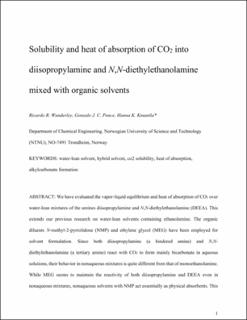Solubility and Heat of Absorption of CO2 into Diisopropylamine and N,N-Diethylethanolamine Mixed with Organic Solvents
Journal article, Peer reviewed
Accepted version
Permanent lenke
https://hdl.handle.net/11250/2676672Utgivelsesdato
2020Metadata
Vis full innførselSamlinger
Originalversjon
10.1021/acs.energyfuels.0c00880Sammendrag
We have evaluated the vapor–liquid equilibrium and heat of absorption of CO2 over water-lean mixtures of the amines diisopropylamine and N,N-diethylethanolamine (DEEA). This extends our previous research on water-lean solvents containing ethanolamine. The organic diluents N-methyl-2-pyrrolidone (NMP) and ethylene glycol (MEG) have been employed for solvent formulation. Since both diisopropylamine (a hindered amine) and N,N-diethylethanolamine (a tertiary amine) react with CO2 to form mainly bicarbonate in aqueous solutions, their behavior in nonaqueous mixtures is quite different from that of monoethanolamine. While MEG seems to maintain the reactivity of both diisopropylamine and DEEA even in nonaqueous mixtures, nonaqueous solvents with NMP act essentially as physical absorbents. This is an important indication that MEG is able to take part in the reaction mechanism between these amines and CO2, perhaps through alkylcarbonate formation, a fact that can be traced back to its relatively low autoprotolysis constant (pKS). This study represents a departure from our previous treatment on loss of CO2 solubility in water-lean solvents with monoethanolamine based on solvation phenomena alone, as it has become clear that the shift in equilibria in solvents with hindered and tertiary amines must account for Le Chatelier’s principle.
